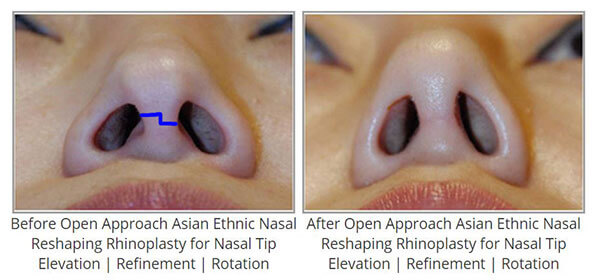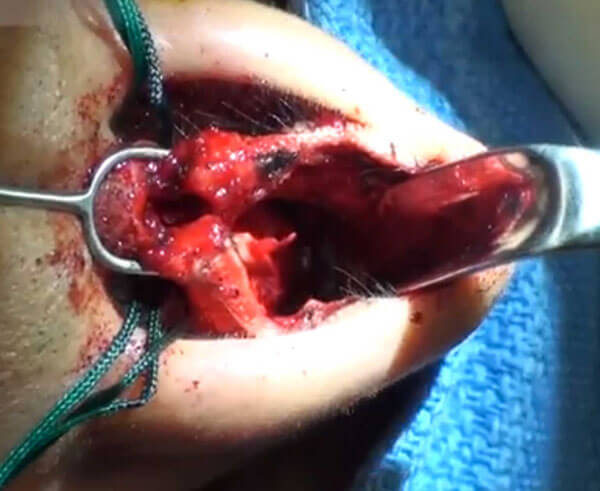Rhinoplasty is one of the procedures that can dramatically change the way you look through a single surgery. Here, we will explain what it means by an open versus closed approach.
This approach is considered by some to be a more up to date way of doing rhinoplasty. The incision is made in between the nostrils in an area called the columella. The columellar incision is central in allowing the surgeon to elevate the skin and get a view of the tip and rest of the nose directly. Below is a picture of the open rhinoplasty approach. The green line shows the inverted gull wing approach:

Below is an example of another kind of open approach incision called the stair step transcolumellar incision. Both are commonly used. I employ the inverted gull wing, which I learned from the Beverly Hills Facial Plastic Surgeons that trained me including Dr. Paul Nassif, Dr. Francis Palmer, Dr. Stephen Pincus, and Dr. Mark Berman.

Below is a picture of the open approach after the incision is made and all the structures are exposed and visualization is maximized.

The reason we went into this discussion is to show you the approach and what we are talking about. With the open rhinoplasty approach the nose is in plain view and you can alter the structures the way you want. Even with this exposure, rhinoplasty is not cut and dry, so to speak. You still have to deal with different compositions of the nose including fat, soft tissue, muscle, bone, cartilage, skin and mucosa and make them work all together. But the Open Rhinoplasty Approach allows you to do this a lot easier.
Opponents of this approach have stated that the scar along the columella is a drawback | negative. Also some feel that the healing time is alot longer with Open Rhinoplasty Method. Because there is an incision there, a possibility of healing issues can occur at this junction and lead to larger skin scars and tissue deficits.
This approach is everything like the open approach accept the transcolumellar incision. The incisions are inside the nose like the open approach but it is not extended into the columella and the structures stay covered. There are ways that the closed approach can deliver the tip cartilages so that you can see them directly. However, this visualization is distorted and does not represent what they actually look like when they are not contorted and pulled to be seen. They only assume there shape once you put the skin back and so never really see how they look with skin retracted back. Closed Approach Positives: Proponents cite the faster healing times, the lack of a scar on the outside, and the decreased chance for damage to the columellar tissue.
* To reduce the risk of bruising, you will be advised to stop taking fish oil, Vitamin E, herbal medications, supplements, aspirin and anti-inflammatories 1-2 weeks prior to treatment, if possible. Inform Dr. Young of all of your prescriptions, over-the-counter remedies and herbal supplements, oral or topical products, and if you may be pregnant.
Please consult our Patient Care section for more helpful information. You can also read about our privacy policy on the resource page as well.
